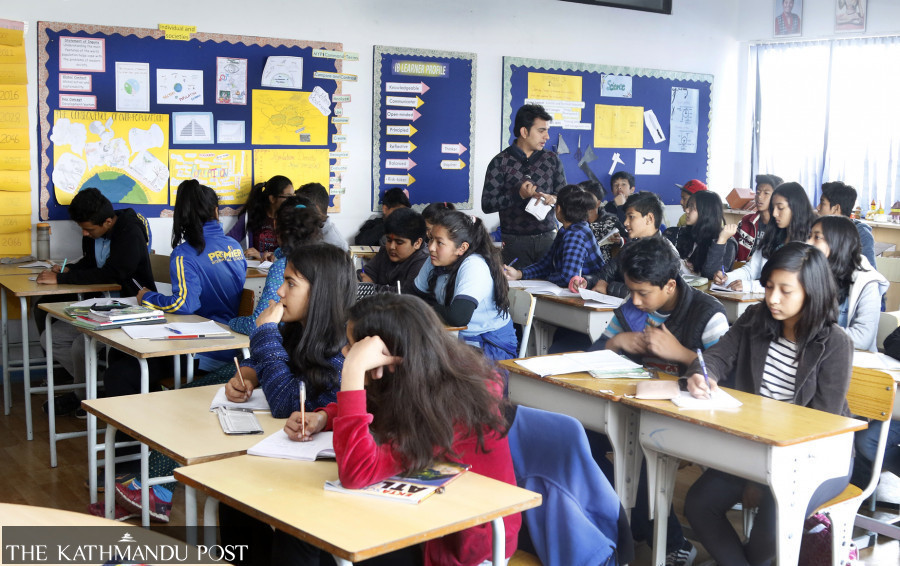National
Suspension of in-person classes takes a heavy toll on pupils’ performance
Study shows 50 percent of guardians reported a decline in academic performance of their wards since the lockdown.
Binod Ghimire
Jinat Siddiqui from St Xavier’s School, Godavari was a bright student until the Covid-induced disruption of in-person classes in schools across the country.
Her school shifted to online learning from March 2020 after the country went into a lockdown to stem the spread of the virus. That was when Siddiqui’s grades began to slide. Siddiqui had been consistently achieving either A or A+ in every subject throughout grade four. When she graduated to grade five two years ago, she could hardly pass her tests. She fared poorly throughout grade six and flunked her final test.
“She is repeating grade six because of her poor performance,” Mustak Alam, Siddiqui’s father, said. “The suspension of physical classes was detrimental to my daughter’s academic performance. She was a bright student but the introduction of online classes distracted her from her studies.”
Siddiqui never took virtual classes seriously and her attention diverted towards online gaming in the last two years, her father says.
“The lockdown ruined her academic performance,” said Alam.
Like Siddiqui, many students both in private and public schools have performed poorly in the last two years, a period marked by frequent lockdowns and disruption of classes.
A recent Child and Family Tracker Survey carried out by UNICEF in April shows that 50 percent of the guardians reported a decline in academic performance of their wards when schools switched to alternative methods of learning-teaching through virtual platforms.
The survey, carried out among 5,825 respondents, suggests that compared to other provinces, children from Karnali have fallen behind in learning the most. The survey’s sixty-four percent of the respondents were those parents whose children were studying in public schools.
Some 80 percent of the total seven million children in Nepal are enrolled in public schools.
The study suggests children from public schools fared poorly than their counterparts in private schools. “Lower-income households were much more likely to report children falling behind,” the study notes. “More than 66 percent of respondents who were struggling for food also reported their children were falling behind. As many as 60 percent of those whose immediate needs were food, employment or financial assistance reported their children had fallen behind.”
Teachers agree that the academic performance of the students has significantly gone down with the suspension of in-person classes. Along with the ineffectiveness of the virtual medium for teaching-learning, the loss of studying habits in most students was the reason behind their poor performance, they say.
Narayan Gautam, the principal of Padmodaya School, Putalisadak, said the decline in the learning achievement of students is disappointing. According to him, students who used to score A+ on average have gone down to A, while A graders have moved down to B+, and so on. “A significant number of students failed in different grades since they couldn’t learn even the minimum of what the curriculum dictates,” Gautam told the Post. “The lockdown affected two consecutive academic sessions weakening the base of even the best performing students. This is going to have a long term impact on the academic future of students.”
A recent report by the Asian Development Bank says school closures would also have a huge impact on Nepal's Gross Domestic Product (GDP). “For South Asia, the effect is deepest in Nepal, where GDP is forecast to fall by 0.48 percent in 2023; 1.4 percent in 2025, 4.3 percent in 2028 and 4.97 percent in 2030 as a result of the school closures,” reads the report.
Nepal is among eight developing nations where the schools were closed for over a year fully or partially, according to the report.
Education experts say the academic performance and learning achievement were bound to fall for two reasons—first, most students didn’t have access to virtual learning platforms, and second, virtual learning wasn’t effective even in cases where platforms were available and accessible. Studies suggest virtual learning was available only to one-third of the students in Nepal.
“The poor learning achievement is surely a cause for concern,” said Binay Kusiyait, a professor at the Tribhuvan University. “There should be some remedial measures in place to support the students to recover from the academic losses. If such students are promoted to higher grades, then their performance could decline further.”
However, the study by UNICEF shows no remedial measures had been taken to make up for the losses. “Close to 50 percent of the respondents said schools were doing nothing to cover the loss,” reads the report. “Most of the respondents suggested extra classes and coaching for support.”




 20.78°C Kathmandu
20.78°C Kathmandu














